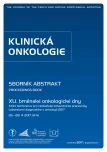Fullerene Doxorubicin Nanotransporter for Target Interaction with mutated gene BRCA2
Authors:
S. Skaličková 1; M. Löfelmann 2; M. Gargulák 2; M. Dočekalová 2; B. Ruttkay-Nedecký 2; P. Suchý 1; M. Kepinská 3; Kizek R. 1–3
Authors‘ workplace:
Ústav humánní farmakologie a toxikologie, Farmaceutická fakulta, Veterinární a farmaceutická univerzita Brno
1; Centrální laboratoře, Farmaceutická fakulta, Veterinární a farmaceutická univerzita Brno
2; Ústav biomedicínských a environmentálních analýz, Wroclaw Medical University, Wroclaw, Polsko
3
Published in:
Klin Onkol 2017; 30(Supplementum1): 177-179
Category:
Article
Overview
Background:
Malignant breast tumors are in developed countries, the most common cancer affecting mainly women. It is estimated that approximately 5–10% of breast cancers are conditioned by genetic family burdens, caused by mutation in the BRCA2 gene. In the course of the treatment doxorubicin is frequently used therapeutics. Despite its therapeutic efficacy, however, it shows high cardiotoxicity. Possibility to increase the therapeutic window, represent nanotransporters. Fullerenes are nanoparticles composed of carbon atoms whose physical-chemical properties indicate high stability. The complex of fullerene and doxorubicin enables the targeted method for the treatment. The aim of this work is to develop a nanotransporter system with an expected cytostatic effect without significant toxic effects.
Material and Methods:
To 5 mg of fullerene 0.5 ml of distilled water was added and solution was subsequently placed for 30 min in an ultrasonic bath (50 W). Fullerenes with bound doxorubicin (DOXO) were purified from unbound DOXO by centrifugation (16,000 g). For DOXO analysis acetate buffer was used. Fe2O3-NPs were prepared by reduction with borohydride and ammonia. Thereafter Fe2O3-AuNPs were prepared by thermal synthesis.
Results:
Carbon nanotransporter (fullerene) for binding of doxorubicin (FULLER-DOXO) was designed and subsequently studied by biophysical methods. We have found that FULLER-DOXO size is larger than 100 nm and the zeta potential is around 24 mV. DOXO, interacts with FULLER by the electrostatic interaction, and its volume increases with the applied concentration (R2 = 0.96). In the following experiment FULLER-DOXO was modified with oligodeoxynucleotide (ODN; 10 µg/ml), and this way was FULLER-DOXO-ODN1 complex prepared. Bound ODN represents a specific sequence for targeting the complex to a point mutation in the BRCA2 gene. In order to prove the interaction magnetic gold nanoparticle modified with the complementary sequence to the test nanotransporter was designed (ODN2-Fe2O3-AuNPs). Formed complex (FULLER-DOXO-ODN1-ODN2-Fe2O3-AuNPs) was subsequently confirmed by several independent techniques.
Conclusion:
We assume that the proposed nanoconstruct will be able to use for genetic targeting of anticancer drug.
Key words:
doxorubicin – breast cancer – fullerenes – magnetic gold nanoparticles
The work was realized with the support of the project NANO LPR 2017 Liga proti rakovině Praha and The European Technology Platform for Nanomedicine.
The authors declare they have no potential conflicts of interest concerning drugs, products, or services used in the study.
The Editorial Board declares that the manuscript met the ICMJE recommendation for biomedical papers.
Submitted:
6. 3. 2017
Accepted:
26. 3. 2017
Sources
1. Martinez-Outschoorn UE, Peiris-Pages M, Pestell RG et al. Cancer metabolism: a therapeutic perspective. Nat Rev Clin Oncol 2017; 14 (1): 11–31. doi: 10.1038/nrclinonc.2016.60.
2. Narod SA. BRCA mutations in the management of breast cancer: the state of the art. Nat Rev Clin Oncol 2010; 7 (12): 702–707. doi: 10.1038/nrclinonc.2010.166.
3. Kizek R, Adam V, Hrabeta J et al. Anthracyclines and ellipticines as DNA-damaging anticancer drugs: recent advances. Pharmacol Ther 2012; 133 (1): 26–39. doi: 10.1016/j.pharmthera.2011.07.006.
4. Blazkova I, Nguyen HV, Kominkova M et al. Fullerene as a transporter for doxorubicin investigated by analytical methods and in vivo imaging. Electrophoresis 2014; 35 (7): 1040–1049. doi: 10.1002/elps.201300393.
5. Drbohlavova J, Chomoucka J, Adam V et al. Nanocarriers for anticancer drugs – new trends in nanomedicine. Curr Drug Metab 2013; 14 (5): 547–564.
6. Lynchak OV, Prylutskyy YI, Rybalchenko VK et al. Comparative analysis of the antineoplastic activity of c-60 fullerene with 5-fluorouracil and pyrrole derivative in vivo. Nanoscale Res Lett 2017; 12 (1): 8. doi: 10.1186/s11671-016-1775-0.
7. Panchuk RR, Prylutska SV, Chumak VV et al. Application of C-60 fullerene-doxorubicin complex for tumor cell treatment in vitro and in vivo. J Biomed Nanotechnol 2015; 11 (7): 1139–1152.
8. Wang H, Agarwal P, Zhao ST et al. A biomimetic hybrid nanoplatform for encapsulation and precisely controlled delivery of therasnostic agents. Nat Commun 2015; 6 : 10081. doi: 10.1038/ncomms10081.
9. Shi JJ, Wang BH, Wang L et al. Fullerene (C-60) -based tumor-targeting nanoparticles with “off-on” state for enhanced treatment of cancer. J Control Release 2016; 235 : 245–258. doi: 10.1016/j.jconrel.2016.06.010.
Labels
Paediatric clinical oncology Surgery Clinical oncologyArticle was published in
Clinical Oncology

2017 Issue Supplementum1
Most read in this issue
- Ascites May Provide Useful Information for Diagnosis of Ovarian Cancer
- Lactate Dehydrogenase – Old Tumour Marker in the Light of Current Knowledge and Preanalytic Conditions
- Molecular Pathology of Colorectal Cancer, Microsatellite Instability – the Detection, the Relationship to the Pathophysiology and Prognosis
- Circulating Myeloid Suppressor Cells and Their Role in Tumour Immunology
